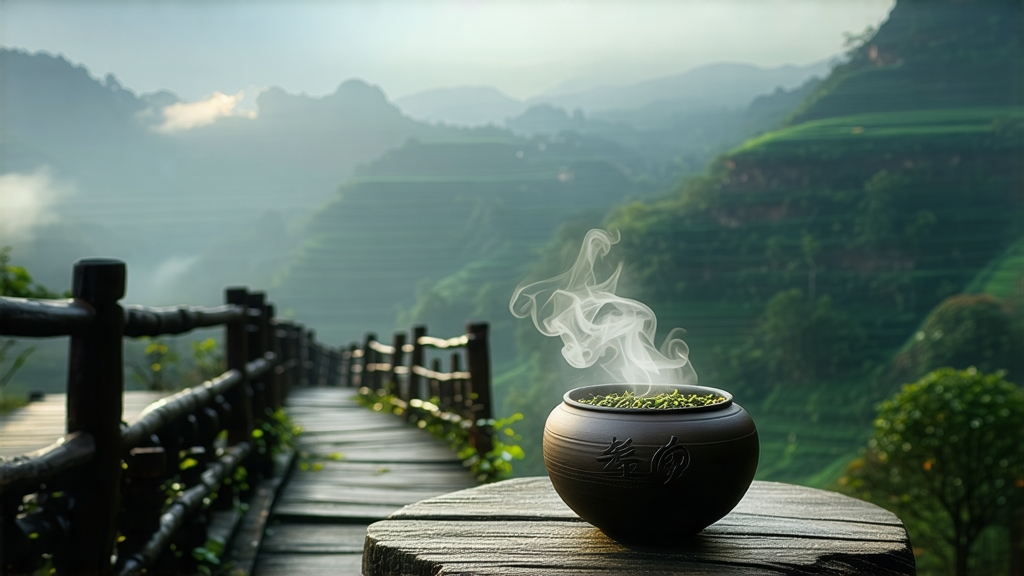
Tucked away in the humid, karst-pocked mountains of southern China’s Guangxi Zhuang Autonomous Region, Liu Bao cha has spent four centuries quietly fermenting its way into the hearts of tea traders, dock workers, and, more recently, global connoisseurs. To the uninitiated it is merely another dark leaf in the vast family of Chinese dark teas (hei cha), yet one sip reveals a liquid archive of monsoon forests, camphor wood warehouses, and the creak of pack baskets on the Tea Horse Road. This article invites you to open that archive—leaf by leaf, bowl by bowl.
-
From Frontier Tribute to Global Cup
Liu Bao’s recorded history begins during the Ming Wanli era (1573–1620), when local Tu and Yao minorities presented compressed baskets of the tea to the imperial court. The Qing Qianlong Emperor (1736–1795) later listed it among the “Eight Tributes of Guangxi,” ensuring annual caravans wound northward. Yet the tea’s real golden age arrived in the late 19th century, when British and Hong Kong merchants shipped it to Malaya, Singapore, and Penang to satiate the thirst of tin-mine coolies who believed Liu Bao dissipated “damp malarial air.” The British, ever pragmatic, weighed it down with iron nails so the chests would not shift in the belly of steamers. Thus a humble mountain tea became a transoceanic currency, and the port of Wuzhou—where the Xun and Gui Rivers converge—turned into the “Canton of Dark Tea.” -
Terroir: Where Rivers Breathe Mist
Liu Bao village itself sits at 200–500 m elevation in Cangwu County, Wuzhou. Granite peaks funnel warm, moisture-laden air up the river valleys, creating year-round relative humidity above 80 %. The soil is lateritic, rich in iron and potassium, and pH 4.5–5.5—ideal for the large-leaf Camellia sinensis var. assamica that has evolved here for millennia. Locals insist that two micro-organisms dominate the leaf surface: Aspergillus niger and Blastobotrys adeninivorans, both critical to the tea’s later fermentation. In short, the mountain breathes, and the tea breathes back. -
Varieties: Red Basket, Green Basket, and the Niche of Old Fir
Although Liu Bao is technically one place-name, the trade recognizes three stylistic tiers.
• Red Basket (Hong Lou, 红篓): The classic grade, packed in 50 kg bamboo baskets lined with palm leaves. Wet-piled for 35–45 days, it delivers cocoa-sweet earthiness and a betel-nut finish.
• Green Basket (Qing Lou, 青篓): Lighter fermentation (20–25 days) and shorter leaf firing preserve a mossy-green vein in the leaf; liquor is chestnut-amber with hints of raw cacao.
• Old Fir (Lao Cong, 老枞): Harvested from seed-propagated bushes over 80 years old growing near fir forests; the trees’ deep roots imbue the leaf with resinous camphor notes. Limited to 300–400 kg per year, it is the darling of auction houses in Guangzhou and Kuala Lumpur. -
Craft: The Alchemy of Water, Heat, and Time
The journey from fresh leaf to fragrant brick is a six-act play:
a) Plucking: One bud with three to four leaves, ideally between Grain Rain and Summer Solstice when polyphenol ratios peak.
b) Solar Withering: Leaves are spread on bamboo screens under morning sun for 2–3 hours until 65 % moisture remains—longer than green tea, shorter than black.
c) Indoor Pile-Fermentation (Wo Dui, 渥堆): Unique to dark teas. The withered leaf is piled 70 cm high in humid rooms (28–32 °C, 85 % RH). Workers turn the pile every three days, spraying it with misty river water to re-inoculate microbes. Over 35 days the leaf turns from olive to ebony, and theaflavins convert to theabrownins, gifting the signature rust-red liquor.
d) Pan-Firing: A 10-minute high-temperature roast at 200 °C arrests enzymatic activity and fixes the color.
e) Compression: While still warm, the